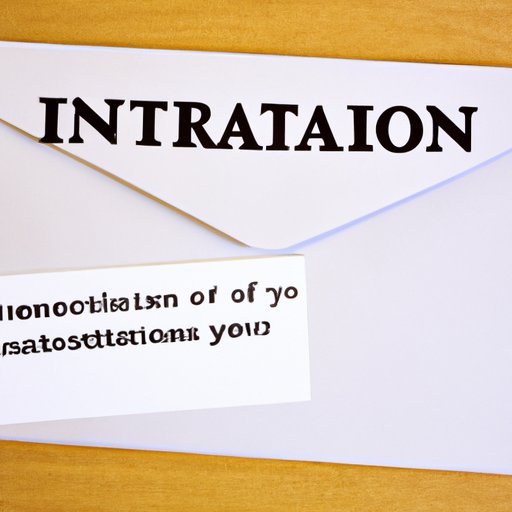Introduction
A letter of interest is a type of professional correspondence used to express an individual’s interest in working for a particular company or organization. Letters of interest are typically sent out when a job opening isn’t available but you want to show the employer that you’re interested in any potential opportunities. They are also sometimes referred to as inquiry letters or prospecting letters.
The purpose of this article is to provide a comprehensive overview of how to start a letter of interest. We will cover all the essential elements that should be included in your letter, from introducing yourself and explaining your interest to outlining your qualifications and demonstrating your knowledge of the company or organization.

Introduce Yourself and Explain Your Interest
The first step in starting a letter of interest is to introduce yourself and explain why you’re writing. This should include a brief overview of who you are and what your background is. You don’t need to go into too much detail here, just enough to give the recipient a sense of who you are and why you’re interested in the company or organization.
After introducing yourself, you should then explain why you’re writing. Make sure to explain what drew you to the company or organization and why you think you would be a good fit. This is your chance to make a good impression, so make sure to highlight what makes you stand out and why you think you would be an asset to the team.
Outline Your Qualifications
Once you’ve introduced yourself and explained your interest, it’s time to outline your qualifications. This is your chance to show the recipient why you’re the ideal candidate for the position (even if one isn’t currently available). Start by listing any relevant education and experience that you have. Be sure to include any special skills or achievements that you think could be beneficial for the company or organization.
You should also use this section to highlight any awards or certifications that you may have received. Doing so will help to demonstrate your commitment to your profession and your dedication to excelling in your field.

Demonstrate Your Knowledge of the Company or Organization
The next step in starting a letter of interest is to demonstrate your knowledge of the company or organization. This is where you can really show off your research skills and prove to the recipient that you’ve taken the time to learn about the company or organization. Start by identifying what you know about the company or organization and then explain how your qualifications fit with what they need.
This is also a great opportunity to mention any connections you may have with the company or organization. If you know someone who works there, be sure to mention it. Doing so shows that you’re invested in the company or organization and that you’re serious about wanting to work there.
Describe Your Professional Goals
The next element to include in your letter of interest is a description of your professional goals. This is your chance to explain your career path and show the recipient how working for the company or organization would fit into your plan. Make sure to be specific and provide details on what you hope to achieve in the future.
It’s also important to explain why you want to work for the company or organization specifically. Show the recipient that you understand the opportunity and why you think you would be a great addition to their team.
Express Your Enthusiasm
The next step in starting a letter of interest is to express your enthusiasm. This is your chance to show that you’re excited to work for the company or organization and that you understand the opportunity. Make sure to be genuine and sincere when expressing your enthusiasm and avoid sounding over the top.
You should also use this section to explain why you think you would be a great fit for the company or organization. Highlight any relevant experience or skills that you have that you think would be beneficial to the team.
Include a Call to Action
The final element to include in your letter of interest is a call to action. This is where you ask for an interview or meeting and provide contact information. Make sure to be polite and professional when asking for an interview or meeting, as this will help to ensure that the recipient takes your request seriously.
It’s also important to provide contact information so that the recipient can easily get in touch with you. Include your email address, phone number, and/or mailing address so that the recipient can reach out to you if they’re interested in learning more.

Close the Letter with Gratitude
Before you close your letter of interest, it’s important to thank the recipient for considering your application. Show your appreciation for their time and let them know that you look forward to hearing back from them. This shows that you’re professional and courteous, which will help to make a good impression.
Conclusion
Writing a letter of interest can seem intimidating, but it doesn’t have to be. By following the tips outlined in this article, you can create an effective and compelling letter of interest that will help you stand out from the crowd. Remember to introduce yourself and explain your interest, outline your qualifications, demonstrate your knowledge of the company or organization, describe your professional goals, express your enthusiasm, include a call to action, and close the letter with gratitude.
If you need any further assistance in crafting a letter of interest, please feel free to reach out. Good luck!
(Note: Is this article not meeting your expectations? Do you have knowledge or insights to share? Unlock new opportunities and expand your reach by joining our authors team. Click Registration to join us and share your expertise with our readers.)
